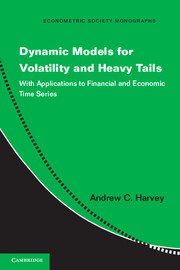 Dynamic Models for Volatility and Heavy Tails
Dynamic Models for Volatility and Heavy Tails Book contents
- Frontmatter
- Contents
- Preface
- Acronyms and Abbreviations
- 1 Introduction
- 2 Statistical Distributions and Asymptotic Theory
- 3 Location
- 4 Scale
- 5 Location/Scale Models for Non-negative Variables
- 6 Dynamic Kernel Density Estimation and Time-Varying Quantiles
- 7 Multivariate Models, Correlation and Association
- 8 Conclusions and Further Directions
- A Derivation of Formulae in the Information Matrix
- B Autocorrelation Functions
- C GED Information Matrix
- D The Order of GARCH Models
- E Computer Programs
- Bibliography
- Author Index
- Subject Index
- Other titles in the series
1 - Introduction
Published online by Cambridge University Press: 05 May 2013
- Frontmatter
- Contents
- Preface
- Acronyms and Abbreviations
- 1 Introduction
- 2 Statistical Distributions and Asymptotic Theory
- 3 Location
- 4 Scale
- 5 Location/Scale Models for Non-negative Variables
- 6 Dynamic Kernel Density Estimation and Time-Varying Quantiles
- 7 Multivariate Models, Correlation and Association
- 8 Conclusions and Further Directions
- A Derivation of Formulae in the Information Matrix
- B Autocorrelation Functions
- C GED Information Matrix
- D The Order of GARCH Models
- E Computer Programs
- Bibliography
- Author Index
- Subject Index
- Other titles in the series
Summary
The aim of this monograph is to set out a unified and comprehensive theory for a class of nonlinear time series models that can deal with dynamic distributions. The emphasis is on models in which the conditional distribution of an observa-tion may be heavy-tailed and the location and/or scale changes over time. The defining feature of these models is that the dynamics are driven by the score of the conditional distribution. When a suitable link function is employed for the changing parameter, analytic expressions may be derived for unconditional moments, autocorrelations and moments of multistep forecasts. Furthermore, a full asymptotic distribution theory for maximum likelihood estimators can be developed, including analytic expressions for asymptotic covariance matrices of the estimators.
The class of what we call dynamic conditional score (DCS) models includes standard linear time series models observed with an error that may be subject to outliers, models which capture changing conditional variance and models for non-negative variables. The last two of these are of considerable importance in financial econometrics, where they are used for forecasting volatility. A guiding principle underlying the proposed class of models is that of signal extraction. When combined with basic ideas of maximum likelihood estimation, the signal extraction approach leads to models which, in contrast to many in the literature, are relatively simple and yield analytic expressions for their principal features.
- Type
- Chapter
- Information
- Dynamic Models for Volatility and Heavy TailsWith Applications to Financial and Economic Time Series, pp. 1 - 18Publisher: Cambridge University PressPrint publication year: 2013
